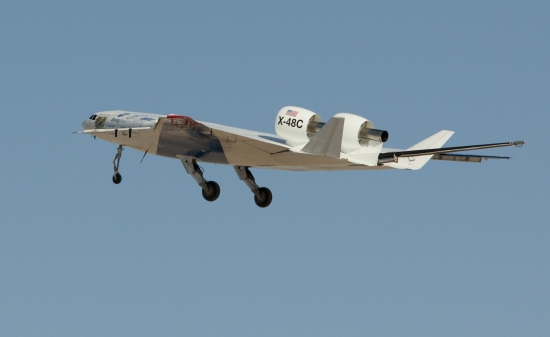NASA-Designed Hybrid Wing Uses Half the Fuel of a Normal Plane, Could be Twice as Awesome
There’s been a lot of focus on hybrid cars in the last few years, but what about other modes of transportation? A team of NASA engineers have shown a new manufacturing method for their “hybrid-wing” design that might cut fuel consumption in half. NASA estimates it could be 20 years before the new production method becomes commercially available, but the technology could begin to help improve conventional aircraft much sooner. Maybe they could use it to fix the battery on the 787?
NASA’s X-48C design uses new, cutting-edge manufacturing techniques, and a very efficient “ultra-high bypass ratio” engine that consumes significantly less fuel than other aircraft. A team from NASA worked in collaboration with Pratt & Whitney and Boeing on the project that cost $300 million. The results included a manufacturing process that could cut the weight of an aircraft by 25%, which would greatly reduce the fuel it consumes.
The reason the new processes will be able to help conventional aircraft years before they develop into full-scale flying wing designs is that a wing design has additional design difficulties that need to be overcome before they can really by used in a large scale.
Maintaining cabin pressure in the tube-like fuselage of a traditional airplane is simpler because of the shape, and it’s also something that engineers and designers have been working on for decades. The fuselage of a wing-shaped design is boxier, and so maintaining cabin pressure presents a new set of problems that need to be dealt with.
The team is working on how to best maintain cabin pressure, and have run tests on sections of the fuselage to see how well it holds up to changes in pressure. By 2015, they expect to have finished building a 30-foot-wide wing-shaped structure to show the feasibility of the design and manufacturing process.
The first benefits of the new designs will come next year when Pratt & Whitney begin using the “ultra-high bypass ratio” engines on their Bombardier C-Series aircraft.
(via Technology Review, image via NASA)
- A guy was asked to remove his Inigo Montoya shirt on a plane
- This startup wants to help you track your lost luggage
- Boeing used potatoes as human substitutes for in-flight WiFi tests
Have a tip we should know? tips@themarysue.com
